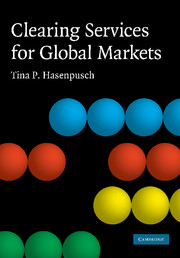 Clearing Services for Global Markets
Clearing Services for Global Markets Book contents
- Frontmatter
- Contents
- List of figures
- List of abbreviations
- Acknowledgements
- Foreword
- 1 Introduction
- 2 Setting the stage – definitions and industry setting
- 3 Defining the core issues – efficiency and network strategies
- 4 Collecting empirical insights – introduction to the empirical study
- 5 Analysing costs of derivatives clearing – transaction cost studies
- 6 Exploring theoretical basics – scale effects in clearing
- 7 What theory reveals – framework for efficiency analysis of network strategies
- 8 Checking theory against reality – case studies of network strategies
- 9 Quantifying the efficiency impact – European network strategies
- 10 Introducing the future network economy – development of the clearing industry
- 11 Summary, discussion and recommendations for future research
- Appendices
- Bibliography
- Index
9 - Quantifying the efficiency impact – European network strategies
Published online by Cambridge University Press: 19 January 2010
- Frontmatter
- Contents
- List of figures
- List of abbreviations
- Acknowledgements
- Foreword
- 1 Introduction
- 2 Setting the stage – definitions and industry setting
- 3 Defining the core issues – efficiency and network strategies
- 4 Collecting empirical insights – introduction to the empirical study
- 5 Analysing costs of derivatives clearing – transaction cost studies
- 6 Exploring theoretical basics – scale effects in clearing
- 7 What theory reveals – framework for efficiency analysis of network strategies
- 8 Checking theory against reality – case studies of network strategies
- 9 Quantifying the efficiency impact – European network strategies
- 10 Introducing the future network economy – development of the clearing industry
- 11 Summary, discussion and recommendations for future research
- Appendices
- Bibliography
- Index
Summary
Analysing the impact of network strategies on the efficiency of European clearing consists of a three-step approach: the findings derived in Chapters 7 and 8 (step 1 and 2) serve as the basis for a quantification of the efficiency impact of European network strategies, which is presented in this chapter (step 3).
First, the quantified efficiency impacts of a European clearing link set-up and a single European CCP are presented in terms of total costs borne by European clearing members (section 9.1). The next section (section 9.2) breaks these costs down into the members' average direct and indirect costs. The calculation of the respective efficiency impact is based on the findings of sections 5.2.3 and 5.2.4, as well as the conclusions derived in Chapters 7 and 8. Finally, a summary of the insights derived in this chapter is provided (section 9.3).
Total European industry costs
Whereas section 5.2.3 introduced an estimate of the total European clearing industry costs in 2005, this section presents the recalculated estimate under the assumption of implemented European clearing links (section 9.1.1) and a single European CCP (section 9.1.2), i.e. quantifies the potential efficiency impact of each network strategy. As the calculation of costs is based on the results presented in section 5.2.3, the same caveats apply to the figures presented in the following. For details on the quantitative analysis and the underlying assumptions, refer to Appendix 8.
- Type
- Chapter
- Information
- Clearing Services for Global MarketsA Framework for the Future Development of the Clearing Industry, pp. 393 - 405Publisher: Cambridge University PressPrint publication year: 2009


